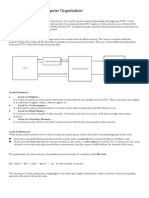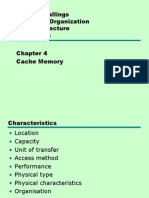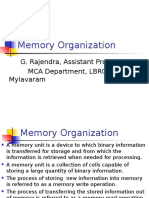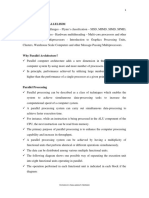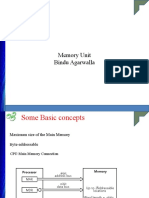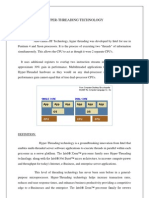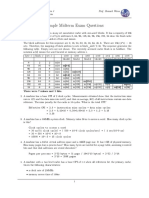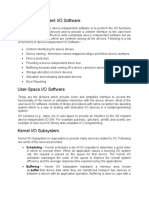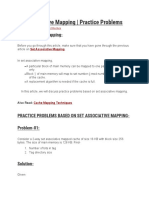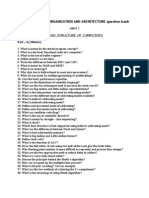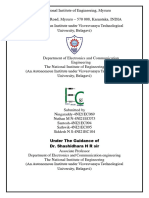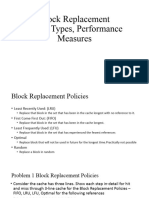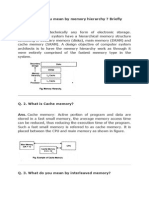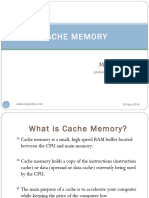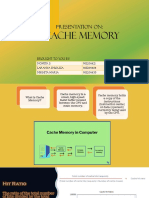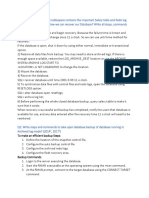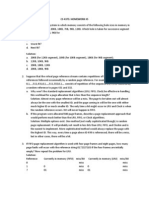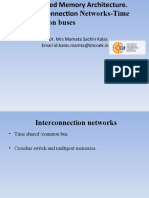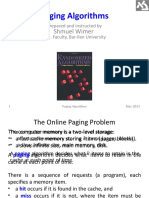CACHE MEMORY
Maninder Kaur
professormaninder@gmail.com
www.eazynotes.com
24-Nov-2010
�What is Cache Memory?
Cache memory is a small, high-speed RAM buffer
located between the CPU and main memory.
Cache memory holds a copy of the instructions
(instruction cache) or data (operand or data
cache) currently being used by the CPU.
The main purpose of a cache is to accelerate
your computer while keeping the price of the
computer low.
2
www.eazynotes.com
24-Nov-2010
�Placement of Cache in computer
www.eazynotes.com
24-Nov-2010
�Hit Ratio
The ratio of the total number of hits divided by the
total CPU accesses to memory (i.e. hits plus
misses) is called Hit Ratio.
Hit Ratio = Total Number of Hits / (Total
Number of Hits + Total Number of
Miss)
www.eazynotes.com
24-Nov-2010
�Example
A system with 512 x 12 cache and 32 K x 12 of
main memory.
www.eazynotes.com
24-Nov-2010
�Types of Cache Mapping
1.
Direct Mapping
2.
Associative Mapping
3.
Set Associative Mapping
www.eazynotes.com
24-Nov-2010
�1. Direct Mapping
The direct mapping technique is simple and inexpensive to
implement.
When the CPU wants to access data from memory, it places a
address. The index field of CPU address is used to access
address.
The tag field of CPU address is compared with the associated
tag in the word read from the cache.
If the tag-bits of CPU address is matched with the tag-bits of
cache, then there is a hit and the required data word is read from
cache.
If there is no match, then there is a miss and the required data
word is stored in main memory. It is then transferred from main
memory to cache memory with the new tag.
7
www.eazynotes.com
24-Nov-2010
�1. Direct Mapping
www.eazynotes.com
24-Nov-2010
�1. Direct Mapping
www.eazynotes.com
24-Nov-2010
�2. Associative Mapping
An associative mapping uses an associative
memory.
This memory is being accessed using its
contents.
Each line of cache memory will accommodate the
address (main memory) and the contents of that
address from the main memory.
That is why this memory is also called Content
Addressable Memory (CAM). It allows each block
of main memory to be stored in the cache.
10
www.eazynotes.com
24-Nov-2010
�2. Associative Mapping
11
www.eazynotes.com
24-Nov-2010
�3. Set Associative Mapping
That is the easy control of the direct mapping
cache and the more flexible mapping of the fully
associative cache.
In set associative mapping, each cache location
can have more than one pair of tag + data items.
That is more than one pair of tag and data are
residing at the same location of cache memory. If
one cache location is holding two pair of tag +
data items, that is called 2-way set associative
mapping.
12
www.eazynotes.com
24-Nov-2010
�3. Two-Way Set Associative
Mapping
13
www.eazynotes.com
24-Nov-2010
�Replacement Algorithms of Cache
Memory
Replacement algorithms are used when there are no available space in
a cache in which to place a data. Four of the most common cache
replacement algorithms are described below:
Least Recently Used (LRU):
The LRU algorithm selects for replacement the item that has been least
recently used by the CPU.
First-In-First-Out (FIFO):
The FIFO algorithm selects for replacement the item that has been in the
cache from the longest time.
Least Frequently Used (LRU):
The LRU algorithm selects for replacement the item that has been least
frequently used by the CPU.
Random:
The random algorithm selects for replacement the item randomly.
14
www.eazynotes.com
24-Nov-2010
�Writing into Cache
When memory write operations are performed,
CPU first writes into the cache memory. These
modifications made by CPU during a write
operations, on the data saved in cache, need to
be written back to main memory or to auxiliary
memory.
These two popular cache write policies
(schemes) are:
Write-Through
Write-Back
15
www.eazynotes.com
24-Nov-2010
�Write-Through
In a write through cache, the main memory is
updated each time the CPU writes into cache.
The advantage of the write-through cache is that
the main memory always contains the same data
as the cache contains.
This characteristic is desirable in a system which
uses direct memory access scheme of data
transfer. The I/O devices communicating through
DMA receive the most recent data.
16
www.eazynotes.com
24-Nov-2010
�Write-Back
In a write back scheme, only the cache memory is
updated during a write operation.
The updated locations in the cache memory are
marked by a flag so that later on, when the word
is removed from the cache, it is copied into the
main memory.
The words are removed from the cache time to
time to make room for a new block of words.
17
www.eazynotes.com
24-Nov-2010
�18
24-Nov-10
www.eazynotes.com

